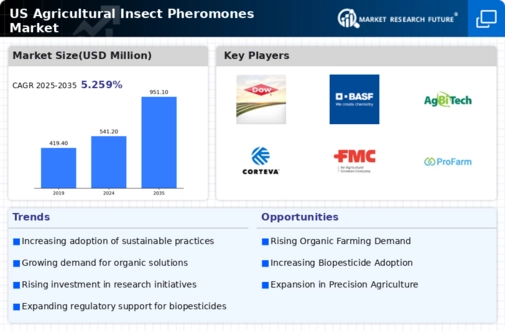The US Agricultural Insect Pheromones Market is experiencing significant competitive dynamics driven by an increasing demand for sustainable agricultural practices and integrated pest management solutions. As growers seek alternatives to chemical pesticides, the adoption of insect pheromones is gaining traction. These pheromone-based solutions play a crucial role in pest control, as they interfere with the mating patterns of various insects, thereby reducing their populations efficiently without harming beneficial species or the environment.
The market is characterized by various key players who are continually innovating and expanding their product portfolios to meet the evolving needs of farmers while enhancing their competitive edge.FMC Corporation is a prominent player in the US Agricultural Insect Pheromones Market, leveraging its extensive research and development capabilities to create effective pest management solutions. The company's strong focus on innovative technologies allows them to offer a wide array of products that cater to diverse agricultural segments.
FMC Corporation's commitment to sustainability and eco-friendly agricultural practices aligns well with the growing awareness among farmers about the potential negative impacts of conventional pest control methods. Their robust distribution network ensures that FMC products are readily available to customers across the US, further solidifying their market presence.
Moreover, the company's strategic partnerships and collaborations with research institutions have enabled it to stay ahead in product development and gain a competitive advantage in the market.Dow AgroSciences, a subsidiary of Dow, is also a key participant in the US Agricultural Insect Pheromones Market, distinguished by its innovative offerings and significant market presence. Known for its expertise in crop protection solutions, Dow AgroSciences provides a range of pheromone products designed to help farmers manage pest populations effectively.
The company emphasizes scientific research and development, ensuring that its solutions are not only highly effective but also cater to the needs of modern agriculture. Dow AgroSciences has made notable investments in the development of targeted pheromone delivery systems that enhance the effectiveness of pest control while minimizing environmental impacts. Furthermore, strategic mergers and acquisitions have bolstered its capabilities, allowing Dow AgroSciences to expand its product line and broaden its market reach within the US, making it a formidable competitor in the agricultural insect pheromones sector.



















Leave a Comment